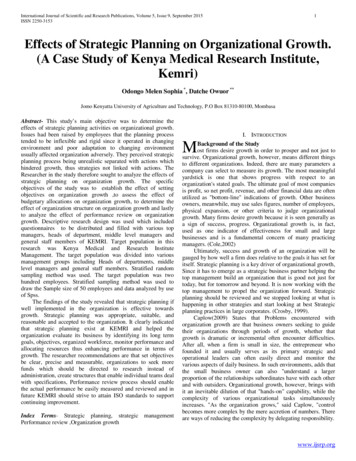
Transcription
International Journal of Scientific and Research Publications, Volume 5, Issue 9, September 2015ISSN 2250-31531Effects of Strategic Planning on Organizational Growth.(A Case Study of Kenya Medical Research Institute,Kemri)Odongo Melen Sophia *, Datche Owuor **Jomo Kenyatta University of Agriculture and Technology, P.O Box 81310-80100, MombasaAbstract- This study’s main objective was to determine theeffects of strategic planning activities on organizational growth.Issues had been raised by employees that the planning processtended to be inflexible and rigid since it operated in changingenvironment and poor adaptation to changing environmentusually affected organization adversely. They perceived strategicplanning process being unrealistic separated with actions whichhindered growth, thus strategies not linked with actions. TheResearcher in the study therefore sought to analyze the effects ofstrategic planning on organization growth. The specificobjectives of the study was to establish the effect of settingobjectives on organization growth ,to assess the effect ofbudgetary allocations on organization growth, to determine theeffect of organization structure on organization growth and lastlyto analyze the effect of performance review on organizationgrowth. Descriptive research design was used which includedquestionnaires to be distributed and filled with various topmanagers, heads of department, middle level managers andgeneral staff members of KEMRI. Target population in thisresearch was Kenya Medical and Research InstituteManagement. The target population was divided into variousmanagement groups including Heads of departments, middlelevel managers and general staff members. Stratified randomsampling method was used. The target population was twohundred employees. Stratified sampling method was used todraw the Sample size of 50 employees and data analyzed by useof Spss.The findings of the study revealed that strategic planning ifwell implemented in the organization is effective towardsgrowth. Strategic planning was appropriate, suitable, andreasonable and accepted to the organization. It clearly indicatedthat strategic planning exist at KEMRI and helped theorganization evaluate its business by identifying its long termgoals, objectives, organized workforce, monitor performance andallocating resources thus enhancing performance in terms ofgrowth. The researcher recommendations are that set objectivesbe clear, precise and measurable, organizations to seek morefunds which should be directed to research instead ofadministration, create structures that enable individual teams dealwith specifications, Performance review process should enablethe actual performance be easily measured and reviewed and infuture KEMRI should strive to attain ISO standards to supportcontinuing improvement.Index Terms- Strategic planning, strategic managementPerformance review ,Organization growthI. INTRODUCTIONMBackground of the Studyost firms desire growth in order to prosper and not just tosurvive. Organizational growth, however, means different thingsto different organizations. Indeed, there are many parameters acompany can select to measure its growth. The most meaningfulyardstick is one that shows progress with respect to anorganization's stated goals. The ultimate goal of most companiesis profit, so net profit, revenue, and other financial data are oftenutilized as "bottom-line" indications of growth. Other businessowners, meanwhile, may use sales figures, number of employees,physical expansion, or other criteria to judge organizationalgrowth. Many firms desire growth because it is seen generally asa sign of success, progress. Organizational growth is, in fact,used as one indicator of effectiveness for small and largebusinesses and is a fundamental concern of many practicingmanagers. (Cole,2002)Ultimately, success and growth of an organization will begauged by how well a firm does relative to the goals it has set foritself. Strategic planning is a key driver of organizational growth,Since it has to emerge as a strategic business partner helping thetop management build an organization that is good not just fortoday, but for tomorrow and beyond. It is now working with thetop management to propel the organization forward. Strategicplanning should be reviewed and we stopped looking at what ishappening in other strategies and start looking at best Strategicplanning practices in large corporates. (Crosby, 1999).Caplow(2009) States that Problems encountered withorganization growth are that business owners seeking to guidetheir organizations through periods of growth, whether thatgrowth is dramatic or incremental often encounter difficulties.After all, when a firm is small in size, the entrepreneur whofounded it and usually serves as its primary strategic andoperational leaders can often easily direct and monitor thevarious aspects of daily business. In such environments, adds thatthe small business owner can also "understand a largerproportion of the relationships subordinates have with each otherand with outsiders. Organizational growth, however, brings withit an inevitable dilution of that "hands-on" capability, while thecomplexity of various organizational tasks simultaneouslyincreases. "As the organization grows," said Caplow, "controlbecomes more complex by the mere accretion of numbers. Thereare ways of reducing the complexity by delegating responsibility.www.ijsrp.org
International Journal of Scientific and Research Publications, Volume 5, Issue 9, September 2015ISSN 2250-3153According to Crosby (1999), organizational growth alsotriggers an almost inevitable "diminution of consensus aboutorganizational goals." He attributed this "in part to the inherentdifficulty of getting a larger number of people who know eachother less well to agree about anything, in part to the importationof new people and ideas, but mostly to the brute fact that as anorganization grows, its relationships to its members and to theenvironment necessarily change.Caplow,(2009) points out that such growth can beparticularly disorienting for employee and owner alike: "oftenthe people involved may not realize that anything significant hasoccurred until they discover by experience that their familiarprocedures no longer work and that their familiar routines havebeen bizarrely transformed .Business owners, then, face adizzying array of organizational elements that have to be revisedin accordance with changing realities. Maintaining effectivemethods of communications with and between employees anddepartments, for example, become ever more important as thefirm grows. Similarly, good strategic planning practices have tobe implemented and maintained. Establishing and improvingstandard practices is often a key element of organizationalgrowth as well. Indeed, a large business that undergoes asignificant burst of growth will find its operations transformed inany number of ways. And often, it will be the owner's advancestrategic planning and management skills that will determinewhether that growth is sustained, or whether internal constraintsrein in that growth prematurely.Strategic planning has been defined as the process offormulating, implementing and evaluating business strategies toachieve future objectives. Formal Strategic Planning began in the1950’s in the United States of America with leading authoritiesbeing Drucker.(Drucker,1970). Ansoff (2007) viewed strategyplanning as the common thread in an Organization’s businessgrowth and the product scope of an organization. All managersare involved in planning but the nature of policies and plans setout by supervisors will vary with each manager’s authority.While senior executives plan the direction of the organization,managers at various levels prepare plans for their own sectionwhich are part of the overall aims of the organization. Strategicplanning involves selecting enterprise goals and departmentobjectives, then finding ways of achieving them. Plans dependupon the existence of alternatives and decisions have to be maderegarding what to do, how to do it, when to do it and by whom itis to be done. A plan is a pre determined course of action whichhelps to provide purpose and direction for members of anorganization. Strategic planning are general and take place at ahigher level in the organization and usually have a longer timehorizon ranging from three to five years or more with annualupdates when need be. (Kreither,2006).To develop a strategic plan, the plan should containstatement of organization mission and goals, strategies forobtaining and utilizing the necessary technological, marketing,and financial and human resources to achieve organization goals.Strategies for manufacturing process and conducting researchand development and utilizing organization and employeecompetencies. The evolution of the field of strategic planningsince its inception has been impressive. From its “humble”beginnings as the limited content of a capstone generalmanagement course in the business school curriculum, strategic2management is now a firmly established field in the study ofbusiness and organizations. During a relatively short period oftime, this field has witnessed a significant growth onorganizations. (Barney, 2014; Wenefelt,2004).Therefore it should be noted that organization growth aremarked by either rapid increases in revenues, company shares,profitability and prospects of it to sustain itself in future.Organization growth has its basis to a larger extend on strategicplanning of the organization. It’s with this respect that strategicplanning should be employed by organization to enhance theirgrowth.(Cole, 2002)KEMRI.The Kenya Medical Research Institute (KEMRI) is a statecorporation established through the Science and Technology(Amendment) Act of 1979, as the national body responsible forcarrying out health research in Kenya. Since its inception,KEMRI has developed a critical mass of scientists and technicalpersonnel, to enable it mount a competitive researchinfrastructure to rank as a leading centre of excellence in healthresearch both in Africa as well as globally.KEMRI Vision is to be a leading centre of excellence inresearch for health and its mission is to improve human healthand quality of life through research, capacity building, innovationand service delivery. KEMRI has a motto that is to be In Searchof Better Health towards the realization of the above statedmission.The core values of the institute are Purity, upholdpurity/sanctity of life. Innovativeness, to be committed topromoting and supporting creativity and innovation. Customerfocus, value customers, and we endeavor to be customer focused.Teamwork, believing there is strength in teamwork and therefore,encourages team spirit in what we do. Uprightness/Integrity,upholding zero tolerance to corruption. Respect & fairness,upholding the philosophy of respect and fairness to all and finallyExcellence, committed to excellence and highest standards ofprofessionalism.KEMRI mandates is to carry out research in human health,cooperate with other research organizations and institutions ofhigher learning on matters of relevant research and training, workwith other research bodies within and outside Kenya carrying outsimilar research, cooperate with the Ministry of Public Healthand Sanitation, the Ministry of Medical Services, the NationalCouncil for Science and Technology(NCST) and the MedicalSciences Advisory Research Committee in matters pertaining toresearch policies and priorities and lastly to do all things asappear to be necessary, describe or expedient to carry out itsfunctions.KEMRI has a service charter that aims to highlight the roleof the Institute, promotes its corporate image. KEMRI promotespublic awareness and services as per specifications. It respondsto all matters promptly and reply to correspondence of all naturewithin a week unless specified otherwise. They uphold highstandards of professionalism in service delivery and zerotolerance to corruption. Their performance is measured throughquarterly and annual performance reviews; Act of feedback andcomments provided by clients and lastly, review of servicecharter every three years or earlier as necessitated. Byimplementing of this Charter all staff members of KEMRI workwww.ijsrp.org
International Journal of Scientific and Research Publications, Volume 5, Issue 9, September 2015ISSN 2250-3153collectively towards the implementation of this charter. Alldepartmental heads are responsible for all its implementation andmonitoring. The public relations office responsible formonitoring the levels of compliance with Charter. website:Http://www.kemri.co.ke1.2 Statement of the ProblemThere has been scarce research on whether parastatals applystrategic planning on their management, (Brendan, 2008). This ispartly due to the fact that less attention on quality of servicesbeing provided by government bodies. This trend changed due togovernment refocusing its effort on improvement of publicservices by implanting strategic planning at their organizations.However, despite claims relating to improvement of public sectorthrough strategic planning implementation, concern has beenraised that not all organizations attempting to develop strategicplans are pleased with the process. Its observes also that theexecutives implementing the planning strategies forgot to matchits plans with the monetary resources which had to be factored intheir organization which hindered growth. (Stonner,2008).Issues have been raised by employees that the planningprocess tended to be inflexible and rigid since it operated inchanging environment and poor adaptation to changingenvironment usually affect organization adversely. They perceivestrategic planning process being unrealistic separated withactions which hindered growth, thus strategies not being linkedwith actions. (Brendan, 2008)This study sought to establish whether planning strategieswere linked with actions in government agencies. The studyexplored ways in which KEMRI adapted to turbulenceenvironment, questions of how strategic plans at KEMRI areflexible, were addressed and highlighedt the role of heads ofdepartment that had direct link at planning and implementationof the strategies set. The study therefore sought to identify theeffects of strategic planning on organization growth.Objectives of this StudyGeneral ObjectiveThe main objective of this study was to determine theeffects of strategic planning activities on organizational growth.Specific Objectives.The specific objectives of this study were:1. To establish the effects of setting objectivesorganization growth.2. To assess the effects of budgetary allocationsorganization growth.3. To determine the effects of organization structureorganization growth.4. To analyze the effects of performance revieworganization growth.ononononII. RELATED LITERATURETheoretical frameworkStrategic planningStrategic planning was about success and failure, about theability to plan wars and win them; big mergers perhaps the mostvisible sign of strategic planning can transform the performance3of an organization, make fortunes for shareholders or change thestructure of an industry (Scholes, 2002). Ineffective strategicplanning can bankrupt companies and win careers of chiefexecutives thus hindering organization growth. Appleby (1994)defines a strategic plan as deciding on major organizational goalsand guidelines or policies used in achieving those goals. Thisplanning relies on an unpredicted long term forecast from seniorlevels of the organization.According to Campbell (1999) and Thompson and Stickland(2007), a strategic plan is a process that involves assessment oftreats and opportunities of an organization, determiningweakness and strengths in changing environment. They continuesaying that a strategy is laid down to cope with the problem athand, considering the goals, objectives of the organization. Theyfurther defines strategic planning as management tool thatcontinually and systematically evaluate a business, identify itslong-term goals and quantifiable objectives, develops a plan toimplement, monitor performance, allocated resources, redefinethe plan where need be, to ensure the organizational memberswork towards the defined goals in changing environment. Torok(1997),observes that strategic plan should ask the questions; Whydo organizations exists, what it does, where it should go and howit is going to get there. Torok (1997) adds that a strategic planshould encompass, a vision, mission and organizational values. Avision is an insight into the long-term future, which should beshort, understood by everyone, describes a static stage. A missionis the route followed to achieve a vision.Appleby (1994), continues to define a mission as anorganization clear objectives depicting its activities hence anarrow purpose. Campbell (1999),further classifies strategicplanning into three levels namely corporate, business andfunctional, which are rated according to time, scope, resourcesand area. Corporate is the highest level with a span of five to tenyears and clearly defines the area of organizational operation andthe overall strategic direction. Business is the mid level with athree to five years span involving entry exit guidelines. Thesestrategies not only involve creating of effective and efficientpractices and procedures but also suitability and costeffectiveness of this program. The lowest level is the functionallevel which is short term ranging a year or less and involvesentry, exit, and procedures. This stage involves day to dayimplementation of the program.Bennett (1996), summarizes the benefit of having strategicplan as follows:- It formulates strategy for the future action andcriteria for the future actions. It makes it easier the coordinationof divisions, subsidiaries and other component parts of theorganisation hence act as the focal point for all operations in theorganisation, the organisation can analysis its position throughstrategy formulation hence know its internal weaknesses andhence how to get a remedy. It makes decision in response topredictable changes, identification of external treats andopportunities. The organisation through speculation of futureevents may lead to influencing the future for the benefit of theorganization growth and after considering all facts importantdecisions can be made hence avoiding crisis situations.Strategic Planning ModelsThe following models provide a range of alternatives fromwhich organizations might select an approach and begin towww.ijsrp.org
International Journal of Scientific and Research Publications, Volume 5, Issue 9, September 2015ISSN 2250-3153develop their own strategic planning process (McNamara, 2000).An organization might choose to integrate the models, e.g., usinga scenario model to creatively identify strategic issues and goals,and then an issue-based model to carefully strategize to addressthe issues and reach the goals.Basic Strategic Planning modelThis very basic process is typically followed byorganizations that are extremely small, busy, and have not donemuch strategic planning before. The process might beimplemented in the first year of the non-profit organization to geta sense of how planning is conducted, and then embellished inlater years with more planning phases and activities to ensurewell-rounded direction for the non-profit. Planning is usuallycarried out by top-level management.The basic strategic planning process includes: Identify thepurpose (mission statement).This is the statement(s) thatdescribes why the organization exists, i.e., its basic purpose. Thestatements will change somewhat over the years. Select the goalsthe organization must reach if it is to accomplish its mission.Goals are general statements about what the organization needsto accomplish to meet its purpose or mission, and address majorissues facing the organization. Identify specific approaches orstrategies that must be implemented to reach each goal. Thestrategies are often what change the most as the organizationeventually conducts more robust strategic planning, particularlyby more closely examining the external and internalenvironments of the organization. Identify specific action plansto implement each strategy. These are the specific activities thateach major function (for example, department, etc.) must4undertake to ensure its effectively implementing each strategy.Objectives should be clearly worded to the extent that people canassess if the objectives have been met or not. Lastly, Monitor andupdate the plan. Planners regularly reflect on the extent to whichthe goals are being met and whether action plans are beingimplemented.Issue - Based (or Goal - Based) Planning modelOrganizations that begin with the «basic» planningapproach described above often evolve to using this morecomprehensive and more effective type of planning. Thefollowing depicts a rather straightforward view of this type ofplanning process, but an organization may not do all of thefollowing activities every year. Thus , External/internalassessment to identify «SWOT» (Strengths, Weaknesses,Opportunities, Threats).Strategic analysis to identify andprioritize major issues/goals. Design major strategies (orprograms) to address issues/goals. Design/update vision, missionand values(some organizations may do this first inplanning).Establish action plans (objectives, resource needs,roles and responsibilities for implementation).Record issues,goals, strategies/programs, updated mission and vision, andaction plans in a Strategic Plan document, and attach SWOT, etc.Develop the yearly Operating Plan document (from year one ofthe multi-year strategic plan). Perhaps the most importantindicator of success of the organization is positive feedback fromthe organization’s customers. Develop and authorize Budget foryear one (allocation of funds needed to fund year one).Lastly,Monitor/review/evaluate/update Strategic Plan documentConceptual FrameworkIndependent variablesSetting ObjectivesDependent variableBudget allocationsOrganization structureGrowth oforganizationPerformance reviewFigure 2.1 Relationships between variablesGrowth of OrganizationOrganizational growth is, in fact, used as one indicator ofeffectiveness for small and large businesses and is a fundamentalconcern of many practicing managers. Ultimately, success andgrowth will be gauged by how well a firm does relative to thegoals it has set for itself. HR is a key driver of organizationalgrowth, Since it has to emerge as a strategic business partnerhelping the top management build an organization that is goodnot just for today, but for tomorrow and beyond. It is nowworking with the top management to propel the organizationforward. HR should be reviewed and we stopped looking at whatis happening in other strategies and start looking at best HRpractices in large corporates. (Crosby, 1999).Caplow points out that such growth can be particularlydisorienting for employee and owner alike: "often the peopleinvolved may not realize that anything significant has occurreduntil they discover by experience that their familiar proceduresno longer work and that their familiar routines have beenwww.ijsrp.org
International Journal of Scientific and Research Publications, Volume 5, Issue 9, September 2015ISSN 2250-3153bizarrely transformed .Business owners, then, face a dizzyingarray of organizational elements that have to be revised inaccordance with changing realities. Maintaining effectivemethods of communications with and between employees anddepartments, for example, become ever more important as thefirm grows. Similarly, good strategic planning practices have tobe implemented and maintained. Establishing and improvingstandard practices is often a key element of organizationalgrowth as well. Indeed, a large business that undergoes asignificant burst of growth will find its operations transformed inany number of ways. And often, it will be the owner's advanceplanning and management skills that will determine whether thatgrowth is sustained, or whether internal constraints rein in thatgrowth prematurely.Setting Objectives.Weinrich, (2007) defines objectives are goals or aims whichthe management wishes the organization achieve. These are theend points or pole-star towards which all business activities likeorganizing, staffing, directing and controlling are decided. Onlyafter having defined those points can the manager determine thekind of organization, the kind of personnel and theirqualification, the kind of motivation, supervision and directionand the kind of control techniques which he must employ toreach those points. Weinrich further states that objectives shouldbe distinguished from three other words ‘vision’ ‘purpose’ and‘mission’. The ‘vision’ is the dream that an entrepreneur createsin his dream that an entrepreneur creates in his waking hours ofhis preferred future. In fact it is the root of all objectives. Thepurpose of an organization its primary role defined by the societyin which it operates. Purpose is therefore a broad aim that appliesnot only to a given organization but to all organizations of itstype in that society. The mission of an organization the uniqueaim that sets the organization apart from others of its type.Objectives are the specific targets to be reached by organization.They are translation of an organization mission into concreteterms against results can be measured.Bernard (2004) identifies the benefits of setting objectivesas follows; it provides a basis for planning and developing othertypes of plans such as policies, budget and procedures. It acts asmotivators for individuals and departments of an enterprisemobilizing their activities with a sense of purpose, it helps indevelopment of effective control that measure results and lead tocorrective actions, it facilitates coordination behavior of variousgroups which otherwise may pull in different directions, theyfunction as a basis for managerial control by serving as standardsagainst which actual performance can be measured, provideslegitimacy to organization activities and finally it facilitate bettermanagement of organization by providing a basis for leading,guiding, directing and controlling the activities of variousdepartments.Hugh and Michael (2002) argues that the one or twosentences vision statements most companies make available tothe company of course provide only a glimpse of what executivesare really thinking and the strategic course they have chartered.Company personnel really have much better understandingwhere the company is headed and why is revealed in the in theofficial vision. But the real purpose of strategic vision is to serveas management for giving the organization a sense of direction.5Like any tool, it can be used properly or improperly, eitherclearly conveying a companies strategic course or not.Hugh and Michael further raise shortcomings in companyvision statements which include: Being vague or incompletesometimes since is short on specifics about where company isheaded or what the company is doing to prepare for future. Beingnot forward looking because it does not indicate whether or howmanagement intends to alter the company’s focus. Being toobroad since it is umbrella-like and all inclusive that the companycould head in most any direction by pursuing or enter mostbusiness. Being uninspiring since it lacks the power to motivatecompany personnel or inspire shareholder confidence aboutcompany’s direction or future prospects.Budget AllocationsMurugan (2006) defines budget as a statement of expectedresults expressed in numeral terms. It may be called a“quantified” plan. A budget may be expressed in financial terms;in terms of labour hours, units of product, or machine hours; or inany other numerically measurable terms. It may deal withoperations, as the capital expenditure budget does, show cashinflow, as cash budget does. However, making a budget is clearlyplanning. He states that budgeting is a significant part of bothplanning and the controlling processes and widely used bymanagers to plan, monitor and control various activities at everylevel of the organization.Tosi (1975) identified some of characteristics of efficientbudgetary system which include budget oriented towards results,budgetary system should be more effective if the duties andresponsibilities for all operations are well defined and rightlyassigned budget should be simple and understandable, fair andobjective. Budget should be based on documentable informationand not simple guesswork and judgment. A quick and two-waycommunication should be adopted so that the managers gettimely information on deviations. Lastly, budget should beviewed as positive and be conducive to self control.Otley (1998) summarizes the benefits of budgets asfollows:Budget help managers in integrating personnel efforts within theorganization towards a common goal, it acts as a control devicesto correct any deviation, it helps in the just measurement ofperformance, it helps management learn from past experiences, itinduces the management to shift attention to future operationsince it is part of planning process and forces managers toanticipate and forecast the trend and changes in the externalenvironment and lastly it facilitates communications throughoutthe organization.However this Arthur, Shane & Mondy (1990) argue thatdespite its benefits, budgeting has become crucial to the planningprocess because budgets are often too rigid and restrictivebecause HR supervisors are given little free hand in managingtheir resources, budget may be changed too often or not at allmaking it difficult for employees to meet performance levels,furthermore, funds are allocated for various activities may not betransferable from one account to another. Budgets are used toevaluate the performance and result but the causes of failures andsuccess are not thoroughly investigated, budgets may usedpuniti
the small business owner can also "understand a larger . of new people and ideas, but mostly to the brute fact that as an organization grows, its relationships to its members and to the . The Kenya Medical Research Institute (KEMRI) is a state c


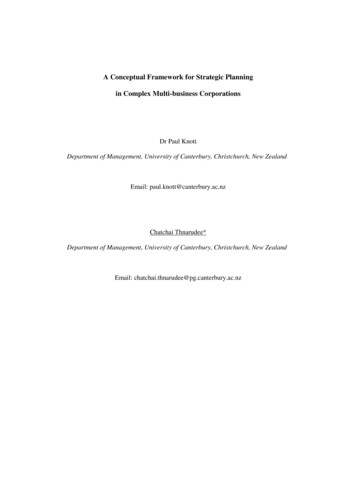
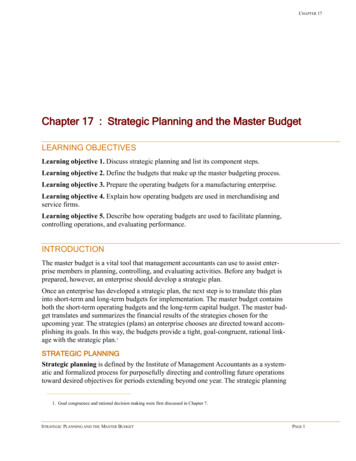
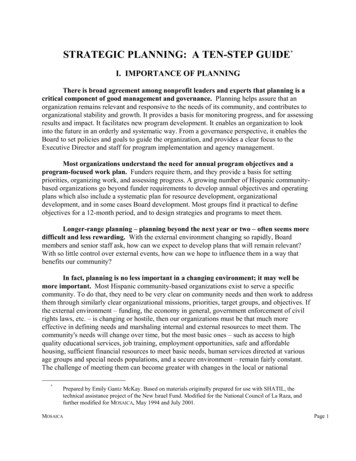
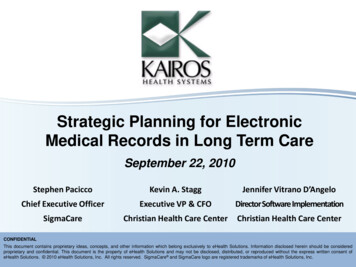
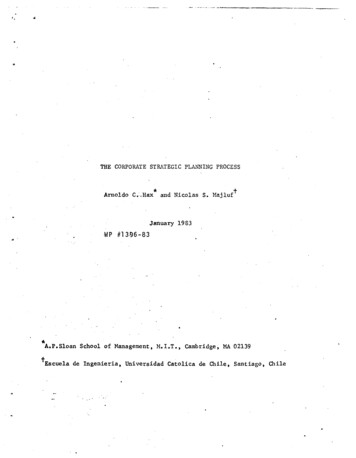
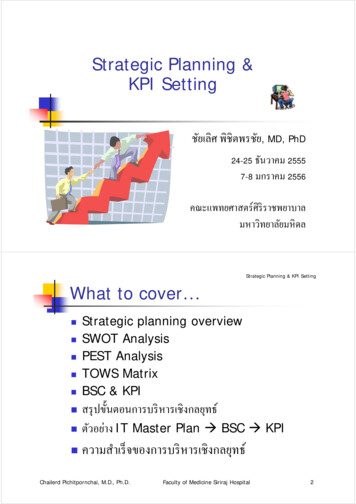


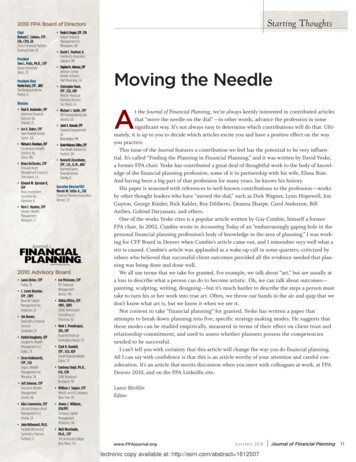
![[digital] Visual Effects and Compositing](/img/1/9780321984388.jpg)